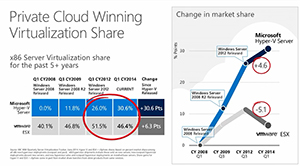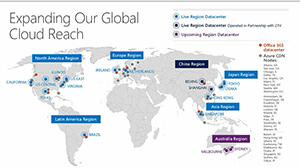News
Microsoft Admits Windows Use at 14 Percent
Microsoft's operating system market position has slipped to 14 percent worldwide, when mobile devices are included in the estimate.
The 14 percent OS figure comes from Kevin Turner, Microsoft's chief operating officer, speaking at this week's Microsoft Worldwide Partner Conference in Washington, D.C. Microsoft still has a 90 percent OS market grip in the PC market, according to Turner, but the majority of computing devices are to be found in the mobile space. To compete, Microsoft is making "hard decisions," including taking zero OS revenue for devices with screens of less than nine inches. Microsoft is adopting a challenger mindset to keep pace, Turner suggested.
The 14 percent figure is a bit shocking to hear, coming from Microsoft. The world has been used to the oft-repeated 90 percent Windows market share that was true when PCs were the predominantly used computing device. However, Turner's 14 percent figure closely corresponds with data released earlier this month by analyst firm Gartner Inc., which projected that Windows devices would hold just 13.7 percent of the total worldwide device market by year's end.
Microsoft is currently working with its partners to deliver lower cost devices for the holidays. Those devices will include seven-inch-screen tablets for $99 and laptops at $199, Turner indicated. Acer and Toshiba may deliver $249 Windows 8 PCs at about that time, which are expected to compete with Google Chromebooks.
Turner said that the next Windows release would be designed to address enterprise needs, as well as those of small-to-medium businesses. He described it as being a "world class" release.
Windows Phone was described as the fasting growing smartphone OS, with 91 percent year-over-year growth. Analyst stats tend to show Windows Phone at a distant third place behind Android and iOS. However, Microsoft contends that Windows Phone is No. 2 in 14 markets. There are about 270,000 apps in the Windows Store, according to Microsoft. Gartner predicts that Windows Phone will have a 10 percent market share in less than four years.
Turner offered up a few other stats in his talk. He suggested that that Hyper-V use has made inroads into VMware's virtualization market hold.
 [Click on image for larger view.]
Figure 1. Hyper-V market share vs. VMware. Source: Microsoft Worldwide Partner Conference 2014 keynote.
[Click on image for larger view.]
Figure 1. Hyper-V market share vs. VMware. Source: Microsoft Worldwide Partner Conference 2014 keynote.
SQL Server has reached the No. 2 place in the database management system market in terms of revenue, according Microsoft, citing IDC and Gartner. Microsoft is also claiming that Dynamics CRM has shown double-digit growth for the past 40 quarters. Half of the Fortune 500 use Microsoft Azure, according to Microsoft. Turner also showed a map of Microsoft's Office 365 datacenters and Azure nodes.
 [Click on image for larger view.]
Figure 2. Microsoft's datacenters worldwide. Source: Microsoft Worldwide Partner Conference 2014 keynote.
[Click on image for larger view.]
Figure 2. Microsoft's datacenters worldwide. Source: Microsoft Worldwide Partner Conference 2014 keynote.
Earlier details about Microsoft Azure were described by Scott Guthrie, executive vice president of the Microsoft Cloud and Enterprise group, in the same keynote address. He said that Microsoft now has "more than 17 Azure regions" around the world. He explained that each region is about the size of two jumbo jets lined up, with a single region capable of housing up to 600,000 servers. He depicted the cloud computing competition as being between just Microsoft, Amazon and Google. However, he claimed that Microsoft has twice more regions than Amazon Web Services and five times more than Google.
Guthrie said that Microsoft had shipped "more than 300 significant new features and services" this year for Microsoft Azure. He added that "more than 57 percent of the Fortune 500 companies" were running on Azure. There are "more than 300,000 publicly facing Web sites on Azure," he claimed.
One of the new capabilities in Azure is the ability to build out a SharePoint farm in minutes, rather than days. Guthrie demonstrated that capability by accessing a SharePoint template from the Azure gallery. Users can specify a single instance or set it up for high availability, he said.
Brad Anderson, corporate vice president for Enterprise Client and Mobility, offered additional Microsoft stats during the keynote talk. He said that Azure Remote App on non-Windows clients have been downloaded "more than 5 million times."
Anderson offered a preview of a new Cloud App Discovery feature in Microsoft Azure. It will scan a computing environment and track the use of SaaS apps, enabling IT pros to see what apps people are using. Anderson also highlighted the Microsoft Azure gallery, saying that Microsoft has integrated "more than 2,000 SaaS apps" into it, which will help IT pros better manage those solutions.
About the Author
Kurt Mackie is senior news producer for 1105 Media's Converge360 group.